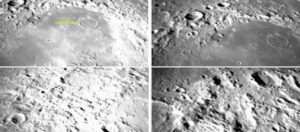Chandrayaan-3’s successful lunar landing opens up exciting avenues for scientific experiments, shedding light on two crucial aspects: lunar quakes and the presence of water-ice on the Moon’s surface. As the spacecraft touches down on the lunar terrain, researchers are poised to delve into these intriguing phenomena, unraveling the mysteries of our celestial neighbor.

The Indian Space Research Organisation (ISRO) successfully landed the Chandrayaan-3 spacecraft on the Moon on August 23, 2023. The lander and rover are now carrying out a series of experiments to study the lunar surface, including lunar quakes and water-ice.
- Lunar Quakes Unveiled:
One of the primary objectives of Chandrayaan-3’s mission is to study lunar quakes, also known as moonquakes. These seismic activities provide invaluable insights into the moon’s internal structure and geological processes. By deploying sensitive seismometers, scientists aim to detect and analyze these quakes, which are triggered by the Moon’s cooling and shrinking over time. Understanding lunar quakes can offer valuable information about the Moon’s history, formation, and potential geological activity.
- Water-Ice Discovery:
Another groundbreaking aspect of Chandrayaan-3’s mission is the exploration of water-ice on the Moon’s surface. Water is a precious resource in space exploration, and its presence on the Moon has far-reaching implications for future lunar missions and even beyond. Researchers suspect that the Moon’s polar regions, particularly the lunar south pole, could harbor water-ice in permanently shadowed craters. Chandrayaan-3 is equipped with instruments to detect and analyze the presence of water molecules, enhancing our understanding of lunar water distribution and its potential utilization in future space endeavors.
- Scientific Significance:
The successful landing of Chandrayaan-3 marks a turning point in our exploration of the Moon. By studying lunar quakes and water-ice, scientists aim to gather crucial data that could reshape our understanding of lunar geology, history, and potential habitability. These experiments not only contribute to the broader scientific community but also pave the way for future missions that could harness lunar resources for sustainable space exploration.
- Implications for Future Missions:
The findings from Chandrayaan-3’s experiments hold immense significance for upcoming lunar missions. Understanding the frequency and intensity of lunar quakes can aid in designing habitats and structures that can withstand seismic activity. Moreover, the identification of water-ice reserves on the Moon could revolutionize space travel, as water is a vital resource for supporting human life and generating propellant.

The Indian Space Research Organisation (ISRO) successfully landed the Chandrayaan-3 spacecraft on the Moon on August 23, 2023. The lander and rover are now carrying out a series of experiments to study the lunar surface, including lunar quakes and water-ice.
One of the key experiments is the Instrument for Lunar Seismic Activity (ILSA). ILSA will measure the size, frequency, and location of lunar quakes. This information will help scientists to better understand the structure and evolution of the Moon’s interior.
The Chandrayaan-3 mission also includes experiments to study the presence of water-ice on the Moon. The rover will carry a drill to collect samples of the lunar soil and regolith. These samples will be analyzed for the presence of water molecules.

Chandrayaan-3’s successful landing ushers in a new era of lunar exploration, where scientific inquiries into lunar quakes and water-ice take center stage. As researchers analyze the data collected by the spacecraft’s instruments, we can anticipate groundbreaking discoveries that not only enhance our knowledge of the Moon but also shape the trajectory of future space exploration missions.
